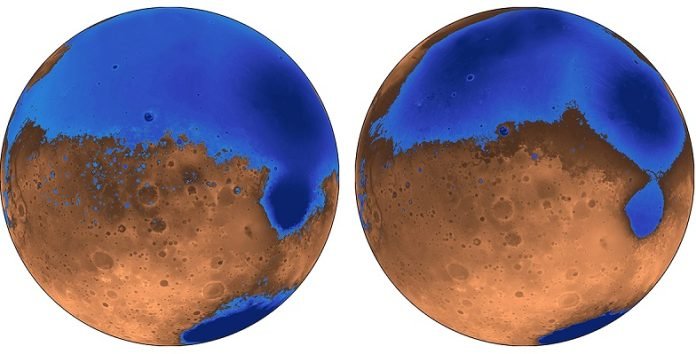
Have you ever wondered how oceans could have existed on Mars billions of years ago?
A new theory suggests that these oceans formed way earlier than we thought and were not as deep as scientists previously believed.
The main culprit behind their formation? The solar system’s largest volcanic system, Tharsis!
Michael Manga, a professor at the University of California, Berkeley, is one of the key scientists behind this theory.
He suggests that the formation of these oceans is closely tied to the rise of the Tharsis volcanic system.
Surprisingly, it was global warming, triggered by the volcanic eruptions, that could have made the existence of liquid water possible on Mars.
There’s been a longstanding debate among scientists about whether Mars ever had oceans. Some skeptics argue that the estimates of the ancient ocean sizes don’t align with how much water could be currently hidden as permafrost or how much could have escaped into space.
Also, the polar ice caps on Mars aren’t large enough to have filled an ocean.
The new model presents an interesting twist. It proposes that the oceans on Mars could have formed either before or simultaneously with the Tharsis volcanic system, rather than after it formed 3.7 billion years ago.
Because Tharsis was smaller back then, it didn’t distort the planet’s landscape as much as it did later on. This means that the early Martian seas could have been shallower, holding about half the water of earlier estimates.
Another common argument against the existence of Martian oceans is the irregular shorelines of the proposed seas. On Earth, shorelines are level, but on Mars, they vary in height by as much as a kilometer.
However, the new theory suggests these irregularities could be due to Tharsis’s growth causing changes to the planet’s landscape and sea level over time.
Tharsis, which is now a gigantic 5,000-kilometer-wide volcanic complex, contains some of the biggest volcanoes in the solar system and has a major impact on the topography of Mars.
Interestingly, Earth, which is twice the diameter and ten times more massive than Mars, doesn’t have any similar dominant feature.
While this theory is exciting, it’s still just a hypothesis. More precise dating of Tharsis and the Martian shorelines will need to be done to see if it holds up. Luckily, NASA’s next Mars lander, the InSight mission, is set to launch soon and could help answer some of these questions.
Who knows, it might even discover remnants of an ancient Martian ocean!
This research is supported by the National Science Foundation, and it’s another step forward in our quest to understand the mysteries of the Red Planet. So, keep an eye out for more Martian revelations!



